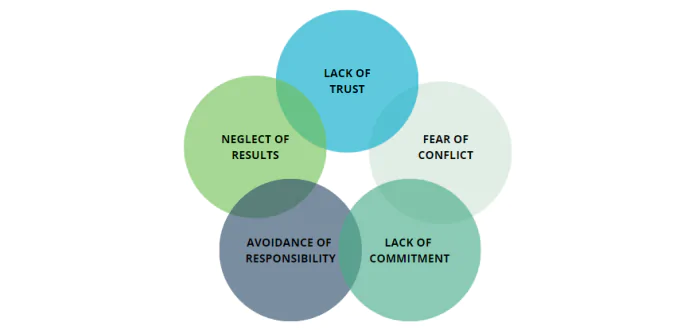The Five Dysfunctions of a Team
The ‘Five Dysfunctions of a Team’ is a model developed by Patrick Lencioni in his business novel of the same name. Patrick Lencioni is a renowned author and consultant in the field of team development. The book was published in 2002 and has since had a significant impact on the world of work and the development of effective teams. In his book, the author uses a formerly successful tech company to describe how teams, whose effectiveness is compromised when they suffer from certain dysfunctions, can plunge a company into crisis.
He identifies the top five challenges that can impede the smooth functioning of a team as follows:

- Lack of trust:
The basis of successful teamwork is mutual trust among team members. If members are unwilling to disclose their weaknesses or mistakes, team communication is limited, and collaboration suffers. As a result, unnecessary wrong decisions can be made because uncertainties were not discussed in advance. In addition, full potential cannot be exploited. All other dysfunctions in Lencioni's model are built on a lack of trust. - Shying away from conflict:
Disagreements are normal and, if handled professionally, can lead to the further development of ideas. However, if team members repeatedly avoid conflicts in order to maintain an artificial harmony, unspoken tensions arise. These inhibit a constructive working atmosphere, and the work results suffer as a consequence. - Lack of commitment:
When team members do not speak openly with each other, it is difficult to make clear decisions and set common goals. Thus, if the established goals are not the result of honest discussion, team members are less likely to actively participate in group processes and feel less responsible for the team outcome. Engagement continues to decline. - Avoidance of responsibility:
In a functioning team, it is important that each person takes responsibility for some part of the team outcome. If team members do not feel obligated to share in decisions because areas of responsibility have not been clearly communicated, there is a lack of individual accountability for the team's success. Each person thinks another person is responsible. The team feeling suffers. - Neglect of results:
The fifth dysfunction is neglect of results. When team members put personal interests, or their own goals above team goals, the focus on the common goal falls by the wayside. This leads to further ineffective collaboration and impairs the achievement of results.
How to counter the dysfunctions:
- Build trust through openness, honesty, and vulnerability.
- Promote constructive conflict by respecting different points of view and facilitating clear communication.
- Make clear decisions and commit to them collectively.
- Emphasize individual responsibility and hold team members accountable.
- Putting the team goal above personal interests and focusing on shared outcomes.
The Importance in the Management Consulting Industry
In the management consulting industry, effective teamwork plays a critical role. Consulting projects often require the coming together of experts with different skills and backgrounds. The lack of trust, open conflict resolution, and individual accountability can hinder the consulting process. To be successful, consulting teams must be able to build trust, constructively confront, engage, and work together toward results.
Above all, customer centricity as the ultimate goal must not be lost sight of.
This model offers valuable insights to identify and overcome dysfunctional patterns in order to operate effectively in management consulting.
